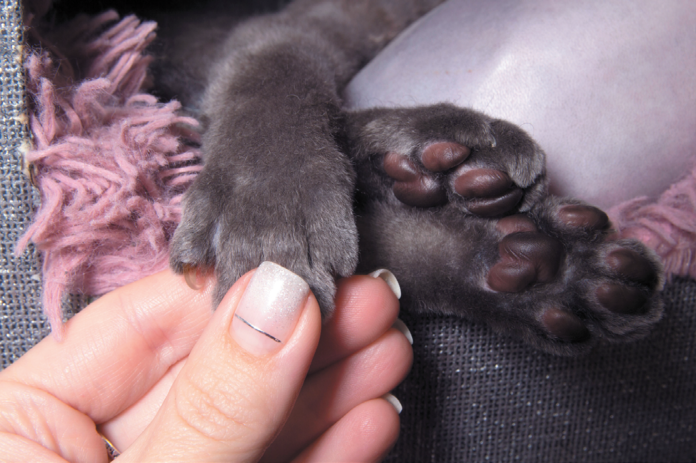You probably know it’s a good idea to trim your cat’s claws every 10 days to two weeks — both for her comfort and your own. But did you know that it’s also important to take routine care of her paws? Here are the steps to take.
Give your cat’s paws a gentle wipe with a damp cloth once a day. If an unhealthy substance ends up on her feet and she then licks it away, she may end up ingesting something she’s not supposed to. Some objects that stick to the bottom of the feet may also cause your cat discomfort, the ASPCA points out.
Keep your floors and other surfaces free not only of debris but also of household chemicals that don’t belong either on your cat or in her if she licks them off. After mopping floors or wiping counters with a cleaning product, immediately remove any residue of the cleanser with a moist cloth.
Give a quick check of your cat’s paws on a regular basis. You’re looking for abnormalities: cuts, sores, splinters, or swelling. Clean small cuts and remove splinters — gently. If there’s an off odor or any discharge, make an appointment to see the veterinarian. There could be an infection that needs professional medical treatment to clear up.
Some long-haired cats have a bit of a fur forest between their toes. There’s nothing wrong with that intrinsically. But if she licks at the patch of hair a lot, it means it bothers her. Make her more comfortable by gently trimming the hair with rounded scissors. (The last thing you want is to risk jabbing your cat with a sharp point when you’re trying to help her.)
In very dry weather (or if your heating system takes the moisture out of the air in your home), consider moisturizing your pet’s feet with an over-the-counter product. Tufts veterinary dermatologist Ramón Almela, DVM, recommends Dermoscent Essential 6 Spot-On.
Keep cats off pavement and outdoor patios in very cold or very hot weather. Temperature extremes are hard on the soles of their feet, as they are on ours.
If your cat seems to be licking or otherwise paying attention to her paws in obsessive fashion, take her to the vet. There’s a good chance that she’s recognizing a problem you might not be able to detect with the naked eye.
Nerve receptors in a cat’s paw pads allow her to feel pressure and vibrations. That assists cats in jumping and other acrobatics.




